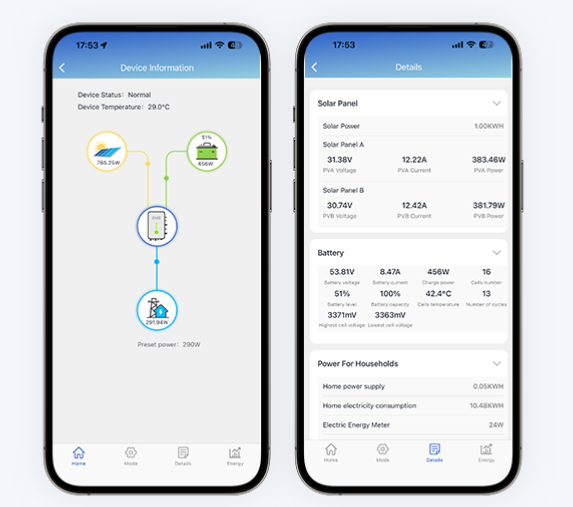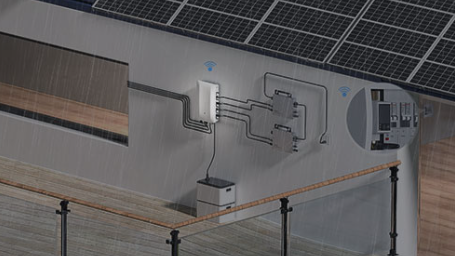Installing a balcony solar energy storage system is a great step toward reducing your carbon footprint, saving on energy bills, and contributing to sustainability. However, like any energy system, it’s important to maintain your solar energy storage system properly to ensure it operates efficiently and lasts for years. Regular maintenance helps maximize energy production, extend the life of your panels and batteries, and prevent costly repairs.
Regularly Clean Your Solar Panels
Cleaning your solar panels is one of the easiest and most effective ways to maintain your system. Dirt, dust, bird droppings, and other debris can block sunlight from reaching the panels, reducing their efficiency. Keeping your panels clean ensures that your balcony solar energy storage system is generating maximum power.
How to Clean Your Panels:
1.Use a soft brush or microfiber cloth: Avoid harsh materials that could scratch the surface of the panels.
2.Use distilled water: If needed, wash the panels with distilled water mixed with a small amount of mild soap to remove dirt and stains. Avoid using high-pressure washers, which can damage the panels.
3.Cleaning frequency: Depending on your environment (e.g., if you live in a dusty area or near trees), you should clean your panels 2-3 times a year. If you notice a significant drop in energy output, it’s a good idea to clean them more frequently.
4.Safety precautions: If you need to climb a ladder or perform cleaning at a height, ensure you take proper safety precautions or hire a professional cleaning service.
Inspect the System for Damage or Wear
Routine inspections are essential for identifying any potential issues with your balcony solar energy storage system before they become serious problems. Regular checks help ensure that your system is functioning efficiently and that components aren’t showing signs of wear or damage.
Key Areas to Inspect:
· Solar Panels: Look for cracks, chips, or discoloration on the panels. If you find any significant damage, it’s essential to have the panels repaired or replaced.
· Cabling and Wiring: Check the wiring for signs of wear or fraying, especially if the cables are exposed to weather elements. Damaged cables can lead to energy loss or system failure.
· Inverter: Ensure that the solar inverter is working properly. Most inverters have indicator lights that show whether the system is functioning correctly. If you notice any unusual behavior (e.g., blinking lights or no power output), consult the manufacturer’s troubleshooting guide or a professional.
· Battery Storage System: If your balcony solar energy storage system includes batteries, check the battery terminals for corrosion, dust, or rust. This can prevent efficient energy storage and transfer.
Frequency of Inspections:
· Quarterly inspections: Perform a basic inspection every three months to catch small issues before they escalate.
· Professional checkup: Once a year, consider having a professional technician inspect your system to ensure everything is functioning optimally.

3. Monitor System Performance Regularly
One of the advantages of a balcony solar energy storage system is the ability to monitor the system’s performance in real-time. Many systems are equipped with smart monitoring apps or built-in digital displays that allow you to track your energy production, consumption, and storage status. Regularly monitoring these metrics helps you spot any performance issues early on.
What to Monitor:
· Energy Generation: Track how much power your solar panels are generating compared to what they are rated for. A significant decrease in power generation could indicate issues like dirt buildup or damage.
· Battery Charge Levels: Check your battery storage levels regularly. If your battery is not charging or discharging properly, it might be time for maintenance or replacement.
· Energy Consumption: Monitor your energy usage to understand how much energy you are drawing from the grid versus what your system is providing. This helps optimize energy usage and reduce dependence on external power.
Many PV hub systems also come with apps that provide insights into solar energy storage, system performance, and even send alerts when something is wrong.
Check Battery Health and Efficiency
The battery storage system is one of the most critical parts of your balcony solar energy storage system. If the battery is not performing optimally, your solar system won’t be able to store and supply energy effectively. Maintaining the health of the battery is crucial for the longevity of your system.
Tips for Battery Maintenance:
1.Avoid overcharging or deep discharging: Most modern solar batteries have built-in charge controllers to prevent overcharging, but it’s still important to be aware of how your battery is performing. Lithium-ion batteries generally last longer if they are not overcharged or fully drained.
2.Keep terminals clean: Inspect the battery terminals for any corrosion or buildup. If you see any, gently clean them with a soft cloth or use a mixture of baking soda and water to remove corrosion. This will help maintain a good connection.
3.Battery lifespan: On average, lithium-ion batteries last 10-15 years, while lead-acid batteries may only last 3-5 years. If your battery is approaching the end of its life, it may not hold a charge as effectively, requiring a replacement.
Battery Maintenance Frequency:
· Check battery health during your quarterly inspections.
· Monitor performance via the app or monitoring system for any signs of decline in storage capacity.
5. Keep the Area Around the Solar System Clean and Safe
Your balcony solar energy storage system can be affected by external factors, so it's important to keep the surrounding area clean and safe. Debris, plants, and pests can interfere with the solar panels and other components.
Best Practices:
1.Clear debris: Remove any leaves, branches, or trash around the system that could obstruct sunlight or damage components.
2.Protect from pests: Ensure that your system is not exposed to pests like rodents, which may chew on cables or wiring. Consider using rodent-proof covers or barriers around exposed wiring.
3.Regularly check for water damage: If you live in a humid or rainy area, ensure that your system is sealed and protected from potential water damage, especially at the junctions of the battery and inverter.
Ensure Proper Ventilation and Cooling
Many solar systems, especially those with battery storage, can heat up, reducing efficiency and lifespan. Proper ventilation is essential to maintain optimal operating temperatures for both your solar panels and battery storage.
How to Keep Your System Cool:
1.Allow airflow: Ensure that there is adequate airflow around your battery storage unit and inverter to prevent them from overheating.
2.Install ventilation systems: If you live in a hot climate, consider installing fans or ventilators around the system to ensure proper cooling.
3.Shade your panels: While solar panels need sunlight, too much heat can affect their efficiency. If possible, place the system in a location where it can get some indirect sunlight in the peak heat of the day, or use shade sails to help protect the panels.



